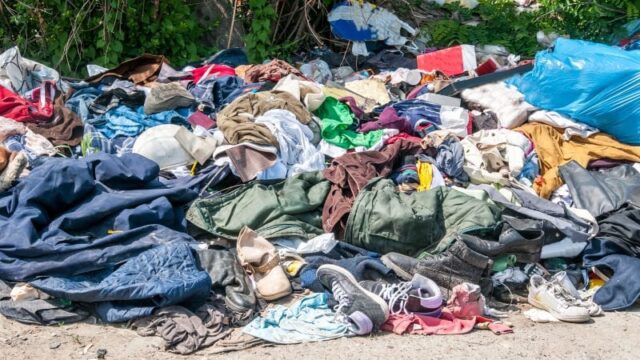In H&M’s flagship Paris store, it is difficult to find clothes that do not claim to be made from “recycled materials”.
Last year, 79 percent of the polyester in its collections came from recycled materials, and next year it wants all of it to be recycled.
The Swedish fast fashion giant told AFP (Agence France-Presse) that recycled material allows the “industry to reduce its dependence on virgin polyester made from fossil fuels. ”
However, Urska Trunk of the campaign group Changing Markets highlighted the problem as, “93 percent of all recycled textiles today comes from plastic bottles, not from old clothes“, or in other words, from fossil fuels.
Not Recyclable?
Basically, clothes made from more than two fibres are for now regarded as unrecyclable, while those that can be recycled must be sorted by colour, and then have zips, buttons, studs and other material removed.
According to experts, it is often costly and labour intensive, though pilot projects are beginning to appear in Europe. However, Urska Trunk says the technology is “in its infancy“.
Reusing cotton may seem like the obvious answer, but when cotton is recycled, the quality drops so much that it often has to be woven with other materials, bringing us back to the problem of mixed fabrics.
To square the recycling circle, fashion brands have instead been using recycled plastic, much to the anger and frustration of the food industry, which pays for the collection of used PET bottles.
“Let’s be clear: this is not circularity,” the beverage industry wrote in a withering open letter to the European Parliament last year in 2023, denouncing the “worrying trend” of the fashion industry making “green claims related to the use of recycled material“.
According to another expert, Lauriane Veillard, of the Zero Waste Europe (ZWE) network, recycling polyester is another dead end since it is often impure and mixed with other materials like elastane or Lycra, which “prevents any recycling“.
Jean-Baptiste Sultan, of the French NGO Carbone 4, is equally damning of polyester saying “From its manufacture to its recycling, (polyester) pollutes water, air and the soil.”
In fact, environmental groups have been demanding that the textile industry stop making polyester completely, despite it accounting for more than half of their output, according to Textile Exchange.
Also Read: “Mother,” Plastic:” Comments Aishwarya Rai Got For Her Look At The Paris Fashion Week
Carbon Footprint?
So, the intriguing question is, where do all those mountains of unrecyclable polyester and mixed fabrics end up after Western consumers dutifully bring them to recycling bins?
Nearly half of the textile waste collected in Europe ends up in African second-hand markets, most allegedly in Ghana, or more often it is tipped into “open landfills“, according to European Environment Agency (EEA) figures from 2019.
Another 41% of the bloc’s textile waste goes to Asia, it added, mostly “to dedicated economic zones where they are sorted and processed“.
“The used textiles are mostly downcycled into industrial rags or filling, or re-exported for recycling in other Asian countries or for reuse in Africa,” the agency claimed.
A new EU rule adopted in November 2023, aims to ensure waste exports are recycled rather than dumped. However the EEA said that there was “a lack of consistent data on the quantities and fate of used textiles and textile waste in Europe“.
Furthermore, NGOs told AFP much of Europe’s waste clothes sent to Asia go to “Export Processing Zones,” which Paul Roeland of the Clean Clothes Campaign said were “notorious for providing ‘lawless’ exclaves, where even the low labour standards of Pakistan and India are not observed“.
Exporting “clothes to countries with low labour costs for sorting is also a horror in terms of carbon footprint“, said Marc Minassian of Pellenc ST, the company which makes optical sorting machines used in recycling.
Recycling ‘myth’:
Greenpeace’s consumer expert Panhuber insisted that the terrible truth is that “recycling is a myth for clothing.” While some experts also warned that we could be falling into another trap. Thomas Ebele of the SloWeAre label questioned the way these non-woven fibres are held together “in the majority of cases” with thermoplastic polyester or PLA.
It means that while the clothing can be “sometimes broken down” it is not recyclable, he added. “Biodegradable does not mean compostable,” he warned, claiming that some of these fibres have to be broken down industrially.
But beyond all that, “the biggest problem is the amount of clothes being made“, said Celeste Grillet of Carbone 4. For Panhuber and Greenpeace, the solution is simple, that is to buy fewer clothes. “We have to decrease consumption,” she said — repair, “reuse and upcycle“.
Image Credits: Google Images
Sources: The Economic Times, The Hindu, Cariki
Find the blogger: Unusha Ahmad
This post is tagged under: fashion, recycling, H&M, Paris, AFP, Changing Markets, European Parliament, Zero Waste Europe, Carbone 4, NGO, Agence France-Presse, Textile Exchange, European Environment Agency, (EEA), Clean Clothes Campaign, Pellenc ST, Greenpeace, SloWeAre, Panhuber
Disclaimer: We do not hold any right, copyright over any of the images used, these have been taken from Google. In case of credits or removal, the owner may kindly mail us.




































